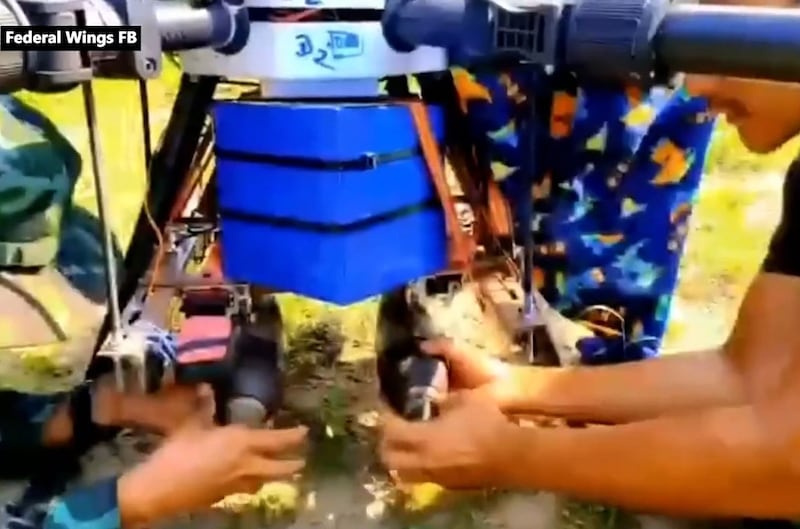Nearly 20 months after the military coup in Myanmar, amid a rapidly intensifying conflict, People’s Defense Force (PDF) paramilitary groups are turning to drone technology to level the playing field as they engage with better-equipped junta troops.
When the PDF formed in the months following the Feb. 1, 2021, military takeover, its members were forced to fight Southeast Asia’s second-largest army using only slingshots and the same crude flintlock “Tumee” rifles their forefathers used to fight off British colonizers in the 1880s. As the network grew, the groups began to use homemade landmines to target their enemy’s convoys.
The latest addition to the PDF arsenal are civilian drones, refitted to drop explosives on junta troops. PDF sources told RFA Burmese that the drones are safe, accurate, and require little manpower to operate during clashes.
Boh Lin Yaung, leader of the Khin-U Support Organization (KSO) in Sagaing region’s Khin-U township, said his group took civilian drones used for shooting video and upgraded them to drop bombs on specific locations.
“Drones have lots of advantages, so we started buying them,” he said.
“Right now, we are working with small drones used for photography, and therefore can only carry small payloads – around half a viss (24 ounces). The main reason we use them is because it’s the safest way for us to engage the enemy.”
Boh Lin Yaung said his group had previously sought to obtain automatic rifles, but decided to use drones instead because of how effective they are for such a low cost point against the junta’s advantages in modern military equipment, training, and supplies.
Members of Sagaing Region PDFs also reported success using drones, although they acknowledged that they are susceptible to being shot out of the sky. They noted that the junta has been using reconnaissance drones to determine their locations and engage them with heavy weapons and airstrikes.
![At left, a bomb [blue] begins to fall towards a target. At right, a bomb hits a Myanmar army trench. Credit: Yangon Revolution Force](https://www.rfa.org/resizer/v2/XAGNCBLCIABJ4TE4JR2LAFHFIU.jpg?auth=08c80743b470f5b3c63b17c6a5ae767665bcdd9225d93dc496d12931c9bcc7b2&width=800&height=269)
‘Our drones dominate the skies’
In Kayin state, where the intensity of fighting rivals that in Sagaing, PDFs are using large-scale drones with six propellers that can carry heavier loads.
Myo Thura Ko, the information officer of the Cobra Regiment, said PDFs have been using combat and patrol drones in Kayin since December 2021.
“The enemy can be easily defeated because the drones unnerve them ... They get scared when they hear the sound of the drones flying,” he said.
“They carry out a lot of airstrikes, but their planes just drop bombs and leave. For the rest of the time, our drones dominate the skies. Our drones also have the ability to scout at night, so they have become a nightmare for the enemy troops.”
Myo Thura Ko said a drone can be equipped with up to five bombs and patrol in dangerous areas using less manpower.
PDFs said the junta has recently begun deploying radio frequency jammers to prevent drones from flying near their camps.
Attempts by RFA to contact junta Deputy Information Minister Major General Zaw Min Tun about the military response to PDF drones went unanswered. However, at a Sept. 20 press conference in the capital Naypyidaw, he told reporters that anti-drone guns have been installed in strategic locations to protect against attack.
Thein Tun Oo, executive director of the Thayningha Strategy Studies Group, a group of former military officers, said PDFs are limited in their ability to attack using civilian drones because of their need for technical support.
“The drones used for spraying chemicals in agriculture called ‘Hexacopters’ have six propellers. They can carry a larger payload and are now being used to drop bombs from the air. But if we look at it from a technical standpoint, the triggering mechanism isn’t simple to operate,” he said.
“In order to overcome this problem, they require support. So this is not a normal development. It’s not something they can do themselves. It's obvious that someone else is providing the technical know-how.”

Shadow govt drone unit
The Ministry of Communications, Information and Technology (MOCIT) under Myanmar’s shadow National Unity Government (NUG) recently formed a “Federal Wings” drone unit manned by tech-savvy youth. The Federal Wings’ social media page claims that the unit has already participated in operations on the battlefield using drones.
The NUG Ministry of Defense also said it is seeking funding to consolidate PDF drone attack forces into an armed force.
Min Zaw Oo, executive director of the Myanmar Institute for Peace and Security, said he expects both sides to increasingly add drones to their arsenals.
“Using drones not only for scouting, but also to deploy weapons, is a development that has come about mostly since the coup,” he said.
“Drones are a widely available technology that can be used by both sides. The role of drones is of growing importance to modern warfare.”
Translated by Khin Maung Nyane. Written in English by Joshua Lipes.
